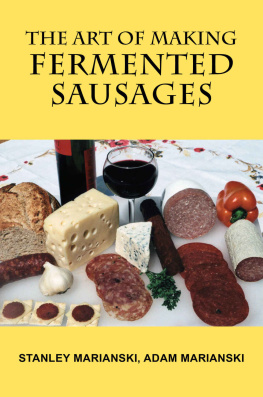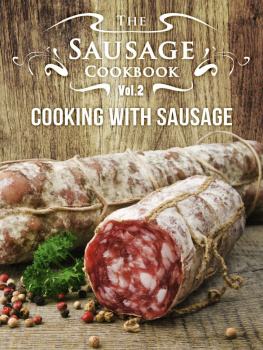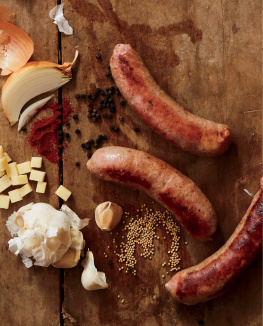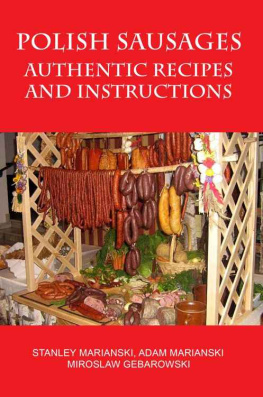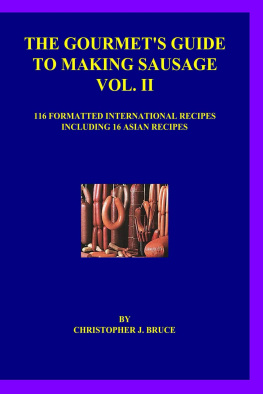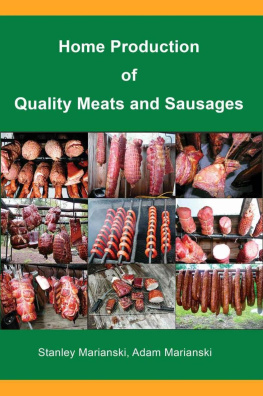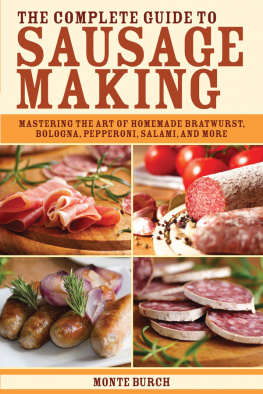Table of Contents

Copyright
Copyright 2015, 2008 by Bookmagic, LLC.
All rights reserved. This book may not be reproduced in any manner without the express written consent of the publisher, except of brief quotations in critical reviews and articles.
The Art of Making Fermented Sausages
Stanley Marianski, Adam Marianski
ISBN: 978-0-9904586-2-3
Library of Congress Control Number: 2009905128
First edition 2008. Second edition 2012. Third edition 2015.
Bookmagic, LLC.
www.bookmagic.com
Disclaimer
This is not a book for someone who has never made a sausage and wants to learn the skill. Basic sausage making steps must be performed at low temperatures quickly, otherwise bacteria growth will escalate. Some hobbyists may perform these operations at higher kitchen temperatures and at such conditions this is not the right place to learn the trade.
This does not mean that fermented sausages cannot be made at home. We have been making them at home for thousands of years and the slow-fermented products made the traditional way still taste better than anything made with expensive microprocessor controlled equipment.
To make great fermented sausages at home you need to:
Learn the underlaying technology behind fermentation in order to understand the process. Get familiar with basic microbiology concepts and learn how to control bacteria. Read the chapter on safety hurdles and follow these rules to the letter.
The main factor that has convinced us to write this book has been the availability of starter cultures from online distributors of sausage making equipment and supplies. Use of starter cultures combined with good manufacturing practices will make production of fermented sausages at home both safe and enjoyable. The information and recommendations contained in the book are presented in good faith and believed to be accurate.
Great Sausage Making
Introduction
Why write a book on making fermented sausages at home? For a very good reason there are none. Most books about home made sausages are written by restaurant chefs or sausage making lovers who have already gained some experience in this field. The majority of those books provide very rudimentary knowledge on making sausages in general, and are loaded with hundreds of recipes which today are available for free on the Internet. These books do not tackle the subject of fermented sausages at all, and limit the discussion to saying that this is an advanced field of sausage making which is not recommended for an amateur sausage maker.
Well, we think that any hobbyist could make a wonderful salami at home if only he knew how. This book aims to convince the reader that he can make any kind of a fermented sausage and the finished product will be both safe and tasteful.
For thousands of years we have been making dry fermented meats without any understanding of the process involved. Only in the last 60 years sufficient advances in the field of meat science were made, namely in microbiology, that discovered underlying reactions that accompany the fermentation and drying of meats. Until then, it was a combination of art and magic and an average hobbyist had nowhere to go.
There were some technical papers that were published in Meat Science and Food Technology journals, which were written by highly respected authorities in this field. People seldom realize that the job of the professor at a known university is not really to teach undergraduates rudimentary knowledge. This job is reserved for teaching assistants who are advanced undergraduates or graduate students pursuing a master degree. Although famous professors do teach masters and doctoral candidates, their main objective is to publish original material to bring fame to their colleges. Unfortunately these highly technical papers are written in such difficult technical terms that most of them are beyond the comprehension of an average person. They might be of interest and probably are even required to be read by college students enrolled in agriculture or meat science courses, but they are of little use to a hobbyist making meat products at home.
Thus, was born the idea of bridging the technology gap that existed between highly technical Meat Science and the requirements of the typical hobbyist making products at home. In order to simplify this knowledge to the absolute minimum, many technical terms were substituted with their equivalent but simpler terms and a number of graphs and tables were provided to make studying easier. To get the reader started, sixty-two sausage recipes supported by detailed instructions are also included.
How Our Book Differs from Others?
We have strived as well as we could to simplify the complexity of meat science and to make it understandable and friendly to a reader without going into technicalities. We could dedicate an entire chapter to a topic of meat color, but instead we explain it in a few practical sentences. The same applies to the science of meat fermentation and to all those wonderful chemical reactions that take place inside.
We aim to stay away from technical jargon and try to use simple colloquial terms instead. It is a kind of a bridge that we hope will connect advanced meat science with a hobbyist, and will bring this heavenly knowledge down to a common ground. Our aim is to help a reader understand different processes such as curing, fermentation or drying, so that he will be able to perform those tasks like a professional but will adapt them to his home conditions.
Until now this field of knowledge has been limited to just a few lucky ones but with todays meat science and starter cultures available to everybody, there is little reason to abstain from making quality salamis at home. By reading this material one can get a full understanding of the process. The purpose of this book is to explain to the reader how he can make those products at home, regardless of the climate and the outside conditions.
Stanley Marianski
Chapter 1 - New Concepts of Vital Importance
Bacteria hate acidity and this fact plays an important role in the production and stabilization of fermented sausages.
The term pH is a measure of acidity; the lower its value, the more acidic the food. Acidity may be natural, as in most fruits, for example lemon, or added, as in pickled food. The acidity level in foods can be increased by adding lemon juice, citric acid, or vinegar, or lowered by adding baking soda, milk or water.
Bacteria will not grow when the pH is below the minimum or above the maximum limit for a particular bacteria strain. All bacteria have their own preferred acidity level for growth, generally around neutral pH (7.0). As the pH of foods can be adjusted, this procedure becomes a potent weapon for the control of bacteria.
The thermal resistance of microorganisms decreases as the pH of their medium is lowered. Most bacteria, particularly Clostridium botulinum, will not grow below pH 4.6. Therefore acidic foods having pH below 4.6 do not require as severe heat treatment as those with pH above 4.6 (low acid) to achieve microbiological safety.
The pH value of 4.6 is the division between high acid foods and low acid foods. Low acid foods have pH values higher than 4.6. They include red meats, seafood, poultry, milk, and all fresh vegetables except for most tomatoes. Although tomatoes generally fall on the pH dividing line at 4.6, there are varieties that have a lower pH level and there are varieties which also have a higher pH level. Tomatoes are usually considered an acidic food.

Next page
